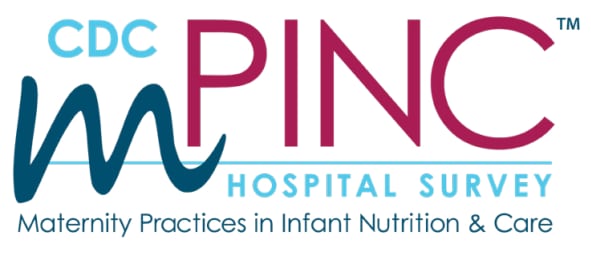At a glance
The Maternity Practices in Infant Nutrition and Care (mPINC) survey provides information that informs hospitals and partners how to improve maternity care practices. Learn more about the mPINC survey.

CDC mPINC Survey Summary
CDC's national survey of Maternity Practices in Infant Nutrition and Care (mPINC) assesses maternity care practices across the United States. It also provides feedback to encourage hospitals to improve breastfeeding support. About every two years, CDC invites all eligible hospitals across U.S. states and territories to complete the mPINC survey. The questions focus on specific maternity care practices that affect how babies are fed.
How can mPINC data be used?
Doctors, nurses, and hospital administrators can use mPINC data to highlight their efforts to support breastfeeding. Health care professionals can also use the data to improve care practices and policies to better support maternity patients. Participating hospitals receive individualized, confidential reports that highlight specific areas where they can change their care practices to better support breastfeeding.
Hospitals can email requests for their mPINC reports to mPINC@cdc.gov. Requests must be sent from an official hospital email address and include the hospital's name and full address.
State health departments and partners can use state mPINC data to support work with partner agencies, organizations, policy makers, and health professionals. The data can help to improve evidence-based maternity care practices and policies at hospitals in their state. Health departments can use their state's mPINC data to develop public health programs. Data requests can be emailed to mPINC@cdc.gov. Learn more about mPINC data requests and confidentiality.
Overview: Maternity care practices
In the United States, nearly all infants are born in a hospital. Their stay is typically brief, but events during this time have lasting effects. Experiences with breastfeeding in the first hours and days of life significantly influence an infant’s later feeding. Several key supportive hospital practices can improve breastfeeding outcomes.
Before an infant is born, birth facility policies and practices that create a supportive environment for breastfeeding begin prenatally and continue through discharge. They include:
- Hospital policies: Written hospital policies that support breastfeeding and are communicated to staff and patients.
- Staff training: Hospital requires breastfeeding education, clinical training, and competency verification for all maternity staff who work with breastfeeding mothers.
- Immediate skin-to-skin contact: Babies are placed skin-to-skin with their mothers immediately after birth, with no bedding or clothing between them. Enough uninterrupted time (at least one hour) is provided for mother and baby to start breastfeeding well.
- Early and frequent breastfeeding: Hospital staff helps mothers and babies start breastfeeding as soon as possible after birth, with many opportunities to practice throughout the hospital stay.
- Teaching about breastfeeding: Hospital staff teaches mothers how to breastfeed and how to recognize and respond to baby's feeding cues.
- Exclusive breastfeeding: Hospital staff follow current evidence-based protocols for breastfeeding infants and provides supplementary feedings only when medically necessary.
- Rooming-in: Hospital staff encourages mothers and babies to room together. Hospital staff teaches mothers the benefits of close contact, including more opportunities to practice breastfeeding and learn their infant's feeding cues.
- Follow-up after discharge: Hospital staff schedules follow-up visits for mothers and babies after they go home and connects them to community breastfeeding resources.
